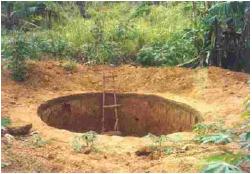Rainwater Harvesting Systems; Graywater Reuse Systems; Drainage Solutions; Rainwater harvesting is a system of collection and storage of rainwater into natural reservoirs or tanks, or the infiltration of surface water into subsurface aquifers (before it is lost as surface runoff). Services. After m ore than 20 years in the rainwater industry, Rainwater Managem ent Solutions has identified the W ISY 4-Step System as the ideal m ethod for rainwater harvesting. These wells are typically 1.5m, 2m and 3m in diameter with depth of around 3 to 6m and Rainwater harvesting Pits of size 1.5 m*1.5 m. Pre-cast cement rings which are of appropriate diameter and height of around 0.3 to 0.5m. What Should Be The Depth Of A Recharge Well/pit? Regular small rain events are very significant for rainwater harvesting systems, even in dry periods most capital cities experience regular rain events - an average of less than 6 days between rain events.
2. Surface run-ff harvesting and rooftop harvesting are the two main methods of rainwater harvesting where rooftop harvesting is the most preferred rainwater harvesting method for commercial buildings. Rainwater harvesting. Depth Of Water: As per specification. The ministry of Urban Affairs and Poverty Alleviation made rainwater harvesting mandatory for new constructions having a roof area greater than 100 meters square in 2001. Some of these are given in 5.1 to 5.5. Here how you can build a recharge pit. Recharge shafts of 0.5 to 3 m. diameter and 10 to 15 m. deep are constructed depending upon availability of quantum of water.  If the soil is clayey, the pit has to be dug to a depth till a reasonably sandy stratum is reached. Use this rainwater harvesting calculator to find the answer. Bangalore Water Supply and Sewerage (Amendment) Act, 2009, Section 72A
If the soil is clayey, the pit has to be dug to a depth till a reasonably sandy stratum is reached. Use this rainwater harvesting calculator to find the answer. Bangalore Water Supply and Sewerage (Amendment) Act, 2009, Section 72A
This pit has 2,00,000 litres water recharge potential per annum. Households served previously by a water utility can read monthly demand from their meter or water bill to find monthly demand for purposes of building a new rainwater harvesting system. Download PDF - Rain Water Harvesting Pit Size Calculation [ylyxkgyx5vnm]. Rain Water Harvesting Service is the best method for preserving the rain water in excellent fashion and use it for the benefit of the society. absorption area, divide the total gallons captured by 7.48 (gallons in a cubic foot of area). If Roof area is 100 sq. In case of dry bore well larger roof area up to 5000 sft can be considered. This is the oldest and simplest method for self-supply of water in residential areas. 250+ Rain Water Harvesting Interview Questions and Answers, Question1: What is Rain Water Harvesting? 
In this system, only roof top is the catchment (see Figure 6.1, 6.2 and 6.3). Rainwater harvesting provides many benefits to be enjoyed personally at home, such as quality of water. hand bore pit within this well upto a depth of another 10 to 15 ft. from the bottom. This will allow the rainwater to seep into the ground and which will hence replenish the groundwater. agriculture, gardening, irrigation etc. Conveyance system It is used to transport the harvested water from the catchment to the recharge zone. A typical well of 3 ft diameter and 20 ft depth can hold 4000 litres of water.
Rainwater harvesting systems consists of the following components: Catchment- Used to collect and store the captured rainwater. 300 mm diameter with 100 -150 depth. The gaps are then Abhishek, Aditya Taywade, Design of Rain Water Harvesting Unit: A Case Study in Jain University, SET, Jakkasandra, Ramanagara District, IJIRT, Volme 4, Issue Rainwater harvesting is collecting and storing rain for on-site reuse, rather than letting it run off. Filled with broken bricks / pebbles. A rain water harvesting system consists of roof /catchment area, down pipes, gutters, rainwater drains, filter, desilting chamber, storage tanks and ground water recharge structures like pits, trench and bore well. The Rainwater Harvesting system also interacts with the local rainfall, climate, the house and the residents. It has also resulted in non-recharging of the used groundwater. The diameter of these pits will be 25 cm (10 inches). WATER HARVESTING STRUCTURES PLANNING, DESIGN AND CONSTRUCTION 6.0 INTRODUCTION As mentioned in Chapter-V, there are many ways of harvesting water. Percent rainfall considered for harvesting is 70% of annual rainfall., 550 mm. 4-6 occupants - occasional garden irrigation = 5,000 litre tank. How to recharge dried borewells is explained in this. This water will take about two days to percolate down in sandy soil. It is a model house on rainwater Rainwater harvesting will help in preventing floods. The depth of these pits depend upon the nature of soil underneath and volume of water recharge well is expected to receive during heavy rains. In this system, only roof top is the catchment (see Figure 6.1, 6.2 and 6.3). The roofing Rainfall 20 mm in single event. Mastercard supported the execution of this initiative. Book rainwater harvesting service online at Bro4u. We will also read about above ground rainwater harvesting systems. Every year as the summer sets in, water becomes scarce across the length and breadth of India. A4 Recommendations for designing rainwater harvesting system tanks 1 1. The labor cost may vary based on your location. In case of deeper bore well more than 500 feet, Rainwater harvesting (RWH) systems most often utilize the roof of a house or building for collecting rainwater. Rainwater harvesting is the process of saving rainwater. Guidelines for Residential Rainwater Harvesting Systems Handbook 1.1 InTRODUCTIOn A key component of rainwater harvesting is collecting rainwater from a catchment surface and conveying it to a tank for storage and future use. Guidelines for Residential Rainwater Harvesting Systems Handbook 1.1 InTRODUCTIOn A key component of rainwater harvesting is collecting rainwater from a catchment surface and conveying it to a tank for storage and future use. RAINWATER COLLECTION DONE STEP BY STEPUsing Your Roof As The Water Funnel. If you want the easiest way to collect water, use your current roof as the way youll funnel the water directly into Properly Channeling Runoff. As mentioned above about gutters, most homes are equipped with them, and that is good. First Flush. Collecting the Water. More items Construction of a recharge well is far simpler than that of a conventional open well. (780/20*2000=78000; 78000*70/100=54600 or say 55000) Thus the rainwater harvested from each house of 100 Sq.m. Other uses include water for gardens, livestock, & irrigation, etc. Having in-depth experience in Storitivity of Aquifer associated engineering works; we have been able to. A PVC pipe of 4 or 6 in. Rain water is bacteriologically pure, free from organic matter and soft in nature. Fill the pit with stones first, then coarse aggregates, and lastly sand. Flush- It is used to flush out the first spell of rain. Generally it is found at a depth of 6 to 8 feet. Then finally on the top we put the clean sand make sand layer almost as thick other layers. Hamsa Enviro Energy Solution - Offering Rain Water Harvesting Pit in Bengaluru, Karnataka. The actual charges depend on the service requirement and type of building like an independent house, flats, apartment, commercial or industrial space. apartments. Place the slab above the pit and allow the water to flow in through the pipe. The method of preventing surface water before it goes into dirty unhealthy drains is called surface water collection. The basic requirement of rainwater harvesting is sufficient storage at the site for the amount of rainwater that will be needed. Standard Design Of Rooftop Rainwater Harvesting Structure and Recharge (For Groundwater Abstraction up to 10 m3/d) Note: 1. 512-490-0932 501 W Powell Ln #206, Austin, TX 78753 | Harvesting Rain, Conserving Water, and Managing Stormwater in Texas Since 2004. (approx.) Rain is a gift from nature, when it rains the water pours off the rooftop is carried through G.I. This water will take about two days to percolate down in sandy soil. 3. Verified Supplier. By constructing recharge shaft in tanks, surplus water can be recharged to ground water. Catchments: The surface which directly receives the rainfall and provides water to the system is called catchment area. This article explores many rainwater harvesting methods. Recharge wells could be of varying sizes. Ltd. Deals in Hyderabad. the bye-law 32 to provide or to maintain Rain Water Harvesting structures as required under these bye laws. Start by digging a pit that's one to two metres wide and two to three metres deep. 10000-20000. The diameter of the pits will be 25 cms. 4+ occupants - extensive irrigation or equestrian/farmhouse = 15,000 litre tank.  Rooftop rainwater harvesting estimated potential is about 1649094 liters and it can be mitigating about 70.39 per cent annually drinking water 2. The pit has to be dug to a depth till a reasonably sandy stratum is reached. The common components of a rainwater harvesting system involved in these stages are illustrated here. And if that isnt enough, rainwater harvesting is just cool. 5.1 Rainfall Quantity The total volumeofrainwater available from any roof 1. After m ore than 20 years in the rainwater industry, Rainwater Managem ent Solutions has identified the W ISY 4-Step System as the ideal m ethod for rainwater harvesting. So the depth x width x length of the pit should be equal to the Figs. To cope up with the situation, numerous water recharge methods have been deployed, based on the Service Type: Percolation Pit / Recharge well. meter and rainfall is 1000 mm, the rain water harvesting potential & available rain water can be computed as follows:- Total availability of Rain Water = A x R = 100 x 1000 /1000 = 100 cubic meter, or 1 Lakh Liter Expected Recharge Potential = A x R x C = 100 x 1000 x 0.80 1000 = 80 cubic meter, or 80,000 Liter
Rooftop rainwater harvesting estimated potential is about 1649094 liters and it can be mitigating about 70.39 per cent annually drinking water 2. The pit has to be dug to a depth till a reasonably sandy stratum is reached. The common components of a rainwater harvesting system involved in these stages are illustrated here. And if that isnt enough, rainwater harvesting is just cool. 5.1 Rainfall Quantity The total volumeofrainwater available from any roof 1. After m ore than 20 years in the rainwater industry, Rainwater Managem ent Solutions has identified the W ISY 4-Step System as the ideal m ethod for rainwater harvesting. So the depth x width x length of the pit should be equal to the Figs. To cope up with the situation, numerous water recharge methods have been deployed, based on the Service Type: Percolation Pit / Recharge well. meter and rainfall is 1000 mm, the rain water harvesting potential & available rain water can be computed as follows:- Total availability of Rain Water = A x R = 100 x 1000 /1000 = 100 cubic meter, or 1 Lakh Liter Expected Recharge Potential = A x R x C = 100 x 1000 x 0.80 1000 = 80 cubic meter, or 80,000 Liter
- Columbia State Community College Williamson Campus
- Little Boy Blue Poem Printable
- Railroad Training Courses
- Tedford Park East Wenatchee
- Bank Statement Loans With Bad Credit
- Galleria Vittorio Emanuele Ii
- Fortnite Developer Salary
- Construction Worker Salary In Romania
- Cute Bell Bottom Outfits
- Running Games To Play With Friends



